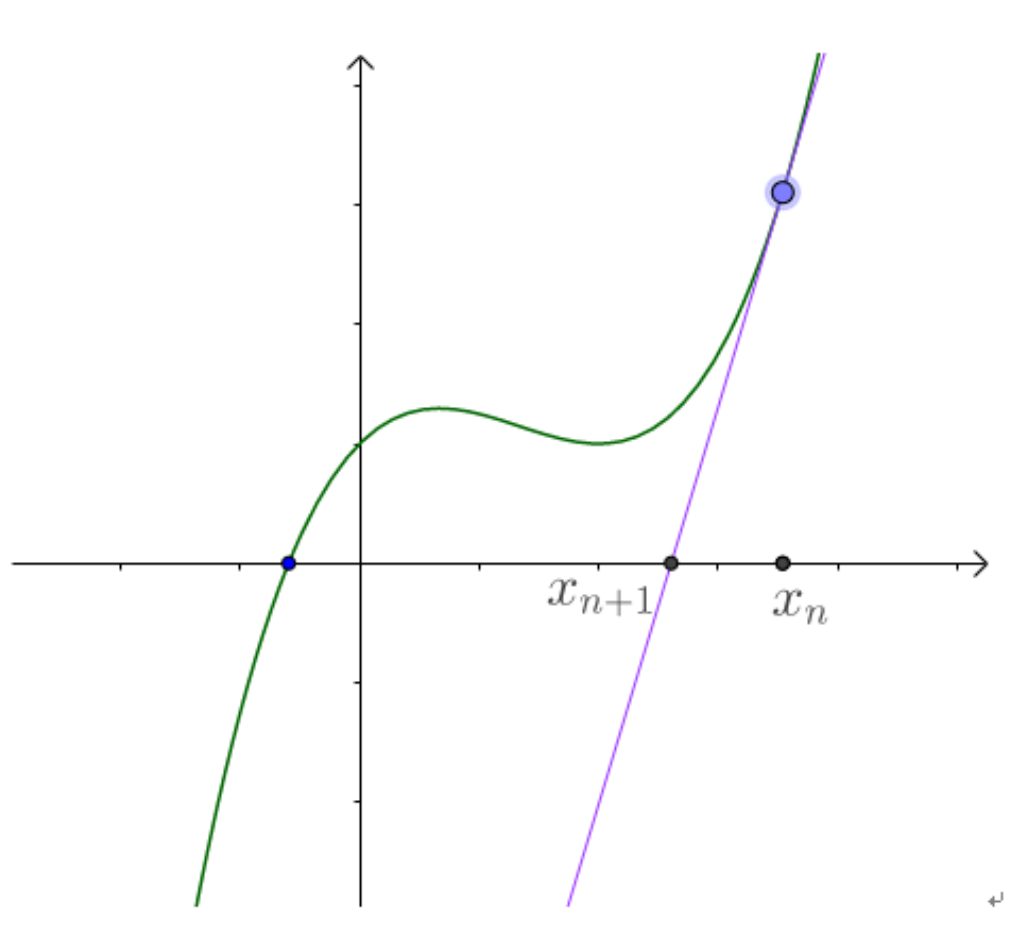牛顿法求平方根
牛顿迭代法

- 如图,一条曲线$y=f(x)$,在$f(x_n)$处画一条切线交x轴于点$x_{n+1}$,接着在$f(x_{n+1})$处画切线交x轴于点$x_{n+2}$,继续……
- 在这个过程中交点$x_{n+m}$会无限逼近曲线零点,即得到方程$f(x) = 0$的解。
求平方根
思路
- 即求函数$f(x) = x^2 - n $的零点
- 导函数$f^{’}(x) = 2x $
- 在点$(x_n, x_n^2-n)$处的切线方程为$y - x_n^2 + n = 2x_n (x-x_n) $,即$y = 2x_nx - x_n^2 - n$
- 则切线与x轴的交点$x_{n+1}$为$$\frac {x_n^2 - n} {2x_n}$$
- 重复迭代直到得到精度满意的值
代码实现
package main
import (
"fmt"
"math"
)
func Sqrt(x float64) float64 {
z := 1.0
for math.Abs(z * z - x) > 1e-12 {
z -= (z * z - x) / (2 * z)
}
return z
}
func main() {
fmt.Println(Sqrt(2))
}
求k次方根
思路
- $$x_{n+1} = x_{n} - \frac {f(x_n)} {f^{’}(x_n)}$$
- $$x_{n+1} = x_n - \frac {x_n(1 - nx_n^{-k})} k$$
代码实现
package main
import (
"fmt"
"math"
)
func getRoot(x, k float64) float64 {
z := 1.0
for math.Abs(math.Pow(z, k) - x) > 1e-9 {
z -= z * (1 - x * math.Pow(z, -k)) / k
}
return z
}
func main() {
fmt.Println(getRoot(27, 3))
}
Benchmark(vs Binary Search)
实现及其测试
// sqrt.go
package sqrt
import "errors"
const EPSILON = 1e-8
var ErrNegativeSqrt = errors.New("cannot Sqrt negative number")
type Float interface {
float64 | float32
}
func abs[T Float](x T) T {
if x < 0 {
return -x
}
return x
}
func SqrtWithNR[T Float](num T) (T, error) {
if num < 0 {
return 0, ErrNegativeSqrt
}
z := T(1.0)
for abs(z*z-num) > EPSILON {
z -= (z*z - num) / (2 * z)
}
return z, nil
}
func SqrtWithBS[T Float](num T) (T, error) {
if num < 0 {
return 0, ErrNegativeSqrt
}
l, r := T(0.0), num
for abs(l*l-num) > EPSILON {
m := (l + r) / 2
if m*m > num {
r = m
} else {
l = m
}
}
return l, nil
}
// sqrt_test.go
package sqrt_test
import (
"math"
"sqrt"
"testing"
)
func TestSqrtWithNR(t *testing.T) {
for i := 0; i < 10; i++ {
num := float64(i)
if z, err := sqrt.SqrtWithNR(num); err != nil {
t.Error(err)
} else if math.Abs(z*z-num) > sqrt.EPSILON {
t.Errorf("%f != %f", z*z, num)
}
}
}
func TestSqrtWithBS(t *testing.T) {
for i := 0; i < 10; i++ {
num := float64(i)
if z, err := sqrt.SqrtWithBS(num); err != nil {
t.Error(err)
} else if math.Abs(z*z-num) > sqrt.EPSILON {
t.Errorf("%f != %f", z*z, num)
}
}
}
func BenchmarkSqrtWithNR(b *testing.B) {
for i := 0; i < b.N; i++ {
sqrt.SqrtWithNR(float64(i))
}
}
func BenchmarkSqrtWithBS(b *testing.B) {
for i := 0; i < b.N; i++ {
sqrt.SqrtWithBS(float64(i))
}
}
测试结果

可以看出牛顿法相比于二分查找,性能要好!🥰